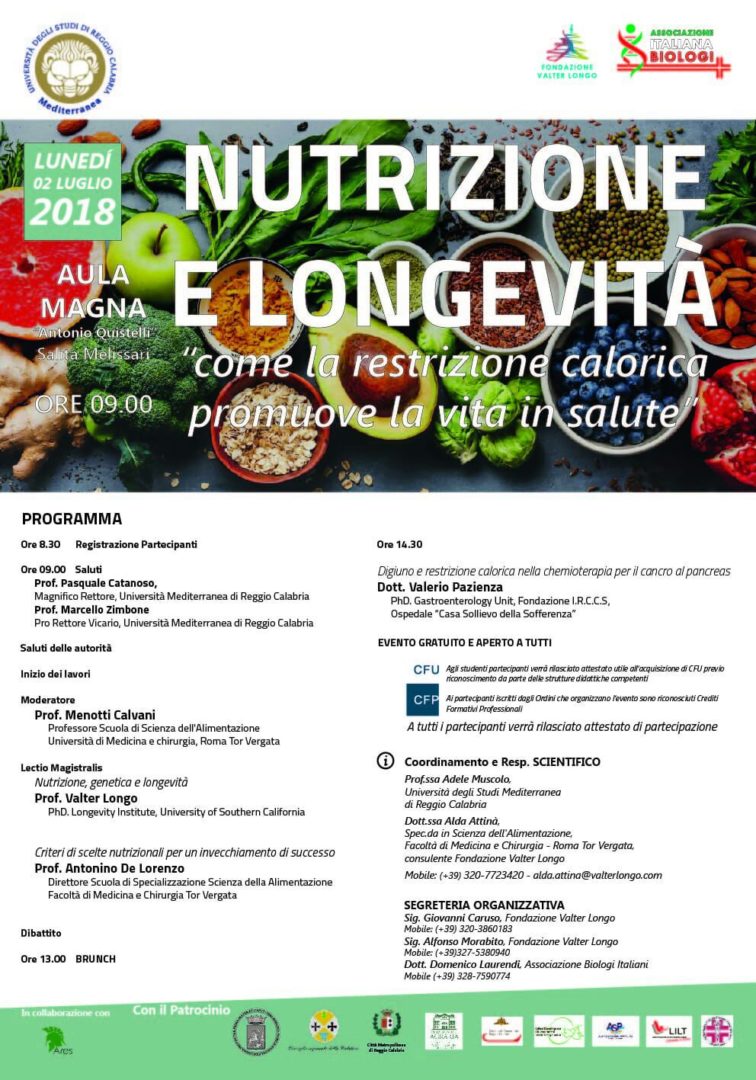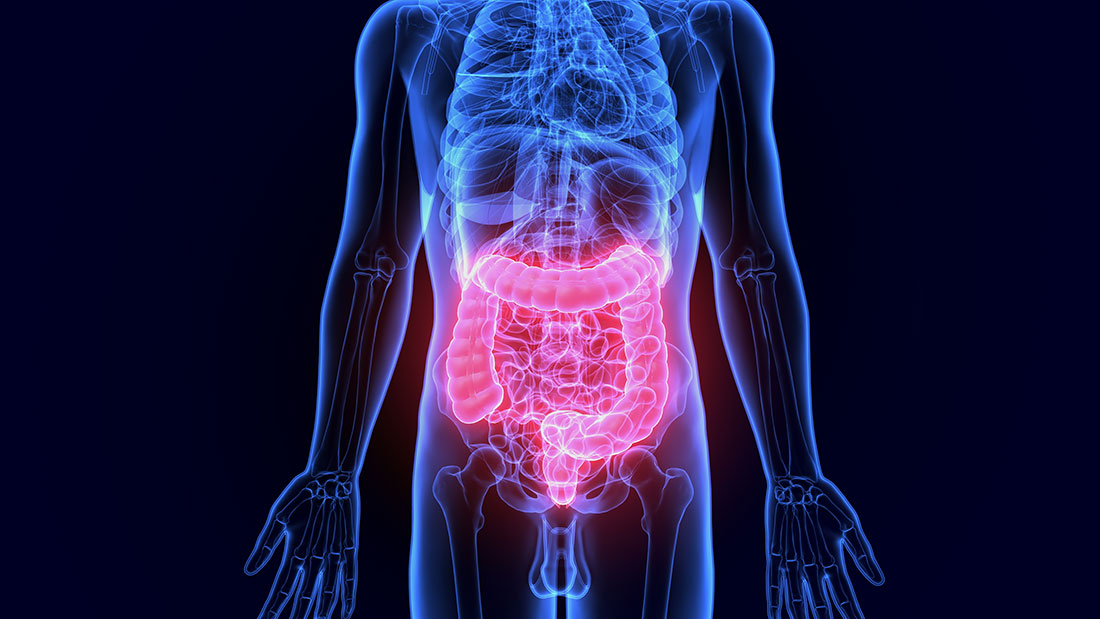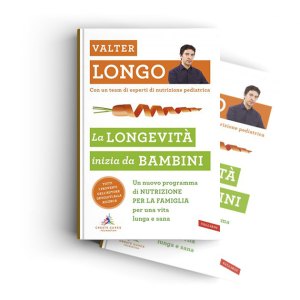Sunday, June 17 in Brescia will host a conference titled “Cancer and Nutrition” which will be attended by Professors Valter Longo, Marco Giorgio of the European Institute of Oncology, Giovanni Apolone, Scientific Director of the IRCCS National Cancer Institute Foundation, and the starred chef Davide Oldani. To testify that good food can also be synonymous with health.
Nutrition And Longevity
ANCONA, June 23rd
Ancona from June 21st to 23rd within the Expo Meeting Innov-Aging project, an event dedicated to the theme of Longevity will be held, promoting a path of health and well-being. On the 23rd, Prof. Longo and Prof. Makoto Suzuki, cardiologist and geriatrician of one of the longest-lived places in the world will speak: Okinawa, in Japan.
A Better Quality of Life and Less Fatigue: New Evidence of the Benefits of Fasting During Chemotherapy
Every year, 8.8 million people worldwide die of cancer and although the recovery rates are increasing, it is estimated that these figures will reach 13 million in 2030. Recently, the journal BMC Cancer published the results of a new clinical trial confirming the benefits of fasting on the quality of life for women diagnosed with breast and ovarian cancer and undergoing chemotherapy, and specifically in the ability of fasting to alleviate fatigue [1]. The paper is authored by a team of researchers from the Department of Internal and Integrative Medicine at the Immanuel Krankenhaus Center, in collaboration with the Institute of Social Medicine, Epidemiology and Health Economics of the Freie University, both in Berlin.
Today, chemotherapy— together with radiotherapy and surgery, is the predominant and most effective treatment to fight cancer. However, cancer patients have long weighed the effectiveness of chemotherapy with its heavy toll on the quality of life. As such, modern medicine—even in the field of oncology— is beginning to pay greater attention to experimental therapeutic approaches. One approach that deserves special recognition are fasting and mimicking diets. This innovative intervention has increasingly produced promising results, both in basic research and clinical trials.
The clinical trial conducted in Berlin studied the effects of fasting on a pool of 34 patients, with an average age of 51 years and no less than 18— all with a diagnosis of breast cancer or ovarian cancer and medical recommendations to undergo standard chemotherapy treatment. The fasting regime, which began 36 hours before the chemotherapy cycles and ended 24 hours after, was administered in two forms: the first group, about half of the patients, underwent Fasting Mimicking Diet (FMD) in the initial phase of chemo, while the second group fasted in the final stage. During the fasting period, patients followed a FMD whose 350 kcal per diem limit—consisting of tea,and vegetable juices and broth. Patients were monitored for the duration of treatment and, in all the observed cases, FMD proved tolerable, causing only minor headaches, nausea or hunger that did not interfere with normal daily activities. Weight loss and reduction of body mass index, typical consequences of chemotherapy, were also limited, with an average variation of less than 1.5 kg in both groups. The improvement in quality of life and reduction of fatigue were more evident for patients who underwent fasting in the initial phase of chemo cycles. This result could be attributed to several factors, notably that fasting appears more effective in preventing the side effects of therapy, than in reversing them.
While the results of this pilot study are certainly encouraging, the implementation of this procedure still requires a degree of prudence in order to avoid potential risks to patients’ health. In particular, it should be noted that not all cancer patients can undergo fasting. Body mass index values lower than 19 kg / m2, a frail physical constitution, and major diseases are incompatible with therapeutic fasting. Rather, for other patients, fasting during chemotherapy treatments is not only feasible but potentially effective. This study confirms as well as adds to the conclusions of previous experimental studies that, since 2008, have demonstrated the efficacy of therapeutic fasting to diminish side effects in mice, but also contributes to the findings of various pilot clinical trials. Regardless of the type of tumor, different fasting protocols in combination with chemotherapy have proven to be safe and even capable of reducing the side effects of pharmacological treatment [2-4]. Hence, fasting can be used as an important tool to enhance the efficacy of chemotherapy. Its primary contribution appears to be that it helps the chemotherapy drugs to identify the cancer cells—under the correct environmental conditions.
Nonetheless, as the antitumor drugs are increasingly specific and selective, detrimental effects on healthy and actively proliferating cells, such as blood cells, hair follicles or reproductive organs, remain unavoidable. Although at the termination of the therapy, in most cases, such cells resume normal activity, it is undeniable that the problem of cytotoxicity can have negative consequences both for the effectiveness of the therapy itself, triggering even some degree of resistance to the chemo drugs, as well as the formation of secondary tumors, especially after several years of treatment.
Under -nutrient-poor conditions (fasting), cancer cells exhibit greater sensitivity to antineoplastic drugs than do normal cells. This phenomenon, referred to as “differential stress resistance”, demonstrates a different metabolic behavior in healthy cells than it does in diseased cells, and is commonly observed in both the simplest and the most complex organisms, such as humans [5-6]. From a biochemical point of view, the protective effect of fasting translates into a significant reduction in blood glucose, insulin, and IGF-1 (Insulin-like Growth Factor) levels, which can facilitate cancer growth. In such a context, where the efficacy of chemotherapeutics is naturally enhanced, the need to increase their doses or to develop more aggressive drugs can be reduced. Thus, investing in such research is costly, but represents a crucial resource in terms of producing tangible benefits for patients.
Indeed, FMD can be an enhancement of conventional cancer therapies given that it does not require an excessive financial investment and is potentially effective both in protecting against various cancer treatments and in increasing their anti-tumor toxicity. Still, further clinical trials are necessary to confirm the efficacy of this approach and thus obtain unanimous recognition by the scientific community.
Sources:
- Bauersfeld S.P. et al. (2018) The effects of short-term fasting on quality of life and tolerance to chemotherapy in patients with breast and ovarian cancer: a randomized cross-over pilot study. BMC Cancer 18: 476.
- Safdie F.M. et al. (2009) Fasting and cancer treatment in humans: A case series report. Aging (Albany NY).1:988-1007.
- de Groot S. et al. (2015) The effects of short-term fasting on tolerance to (neo) adjuvant chemotherapy in HER2-negative breast cancer patients: a randomized pilot study. BMC Cancer 15:652.
- Dorff T.B. et al. (2016) Safety and feasibility of fasting in combination with platinum-based chemotherapy. BMC Cancer 16:360.
- Lee C and Longo VD. (2011) Fasting vs dietary restriction in cellular protection and cancer treatment: from model organisms to patients. 30:3305–16.
- Raffaghello L. et al. (2008) Starvation-dependent differential stress resistance protects normal but not cancer cells against high-dose chemotherapy. Proc Natl Acad Sci U S A 105:8215–20.

NICOLETTA GUARAGNELLA
Researcher at the Institute of Biomembranes,
Bioenergetics and Molecular Biotechnologies of the National Research Council, Bari
Scientific communicator
Healthy diet and weight, not smoking and regular exercise are associated with a 12-14 years longer lifespan and an over 65% reduction in the risk of mortality from cancer and cardiovascular disease.
Healthy diet and weight, not smoking and regular exercise are associated with a 12-14 years longer lifespan and an over 65% reduction in the risk of mortality from cancer and cardiovascular disease.
A study conducted at Harvard on more than 120,000 men and women, and published in the journal Circulation, reports that following several healthy lifestyles can increase life expectancy, reduce mortality from cardiovascular disease by 82% and tumors by 65%. Discover how to improve your life style reading the following article!
According to the research of Professor Longo, new guidelines show that a healthy lifestyle can reduce the risk of cardiovascular diseases up to 80%, and the risk of tumors up to 60%.
Three out of four deaths from cardiovascular diseases and half of deaths from cancer are likely caused by an unhealthy lifestyle. Is there hope for beating these odds? Can anything be done to improve our chances before such diseases?
To answer these questions, researchers led by Professor Frank B. Hu of Harvard University drew on the data of two extensive studies that analyzed the US population.
The findings are astonishing: small changes in lifestyle can increase life expectancy by years.
What does this new study offer?
Published in the April 2018 issue of the prestigious journal Circulation, the findings of the research team at Harvard University, confirm findings previously reported in other scientific journals—yet, with a key difference. Whereas previous studies examined the populations of various countries, this study conducted a thorough and quantitative analysis targeting the US population only. Instead, a 2012 meta-analysis collected the data from more than a half million participants from the US, Europe, China, and Japan, for an average of 13 years. The data suggested that more than half (66%) of premature deaths are associated with an unhealthy lifestyle that includes smoking, excessive alcohol consumption, lack of exercise, poor dietary choices, and obesity.
The data pool was drawn from more than 120,000 people (78,865 women and 44,354 men, chosen from two groups commonly used as research subjects in epidemiology; these groups’ traits are listed in below).
1. Who were the participants in the study?
The Harvard research team led by Professor Frank B. Hu used the data of two extensive studies that were conducted over 30 years and profiled over thousands of US health professionals, including both women (NHS, “Nurses Health Study”) and men (HPFS, “Health Professionals Follow-up Study”). The participants regularly fill out questionnaires on diet, health and other personal information (age, ethnicity, use of medicine, etc.)
This data was then integrated with that of the official program that evaluates the nutritional status of adults and children in the US (NHANES, The National Health and Nutritional Examination Survey”), and with an online database used to analyze data on public health (CDC WONDER, “Centers for Disease Control and Prevention Wide-Ranging Online Data for Epidemiologic Research”).
The results? In contrast to less regimented peers of the same age, women who follow a healthy lifestyle can live as many as 14 years longer, while men have the potential to add 12 years to their lives. This means that when 50 years old, the life expectancy is increased by 43 years for women, and approximately 38 years for men—great news for those hoping to enjoy their retirement years with grandchildren or traveling around the world. The most important aspect is that these people also are healthier in their later years. In fact, the study determined that by following the proper guidelines, people have an 82% less chance of dying from cardiovascular diseases and 65% less chance of dying from tumors.
What does it mean to follow “a healthy lifestyle”?
Diet is without a doubt ranked at the top of factors determining overall health. In the Harvard-based study, a healthy diet is defined as one that emphasizes vegetables, fruit, nuts, whole grains, polyunsaturated fats and long-chain omega-3 fatty acids (prevalent in fish, for example, and nuts like walnuts and almonds, as well as extra-virgin olive oil). Instead, it restricts the consumption of red meat, sugary beverages, animal fats and sodium (too much salt). Harvard researchers measured a healthy diet by using an index called The Alternate Healthy Eating Index, which awards points based on the consumption of more or fewer of the above dietary products. Those participants scoring more than 40% are deemed to have a healthy diet as they consume food items considered healthy while limiting the unhealthy items.
Diet must be accompanied by a sufficient amount of moderate or intense physical activity at least 30 minutes a day (no need to join a gym—brisk or fast walking also counts!)
Not surprisingly, smoking should be avoided at all costs. Moreover, alcohol should be consumed in moderation; for men, this means approximately 2 small glasses of wine, 2 bottles of beer or 2 small shot glasses of hard alcohol (40 ml) a day, while for women half these amounts.
The last risk factor is weight, or rather Body Mass Index, known by the English acronym BMI, which is calculated by dividing your weight in kg by your height in meters. Your BMI should be between 18.5 and 24.9. For example, a person 1.6 meters should weigh between 47.5 and 64 kg, 55 kg being the ideal.
Do you want to find out if you have a healthy lifestyle? Answer the questions below.
2. What is your score?
Your lifestyle can be considered “healthy” if you responded “Yes” to these questions.
1. How does your diet compare to the Longevity Diet? Does it follow the same or similar guidelines?
2. Do you do a minimum of 30 minutes of exercise each day?
3. Are you a non-smoker?
4. Do you drink no more than 1 glass of wine per day (for women) or 2 for men?
5. Is your BMI between 18.5 and 24.9?
Why are these findings so important?
Well-being is not necessarily the same as good health. The US spends more than 17% of its GDP on healthcare. More resources are spent on developing new drugs and providing treatment than on prevention. Like all industrialized nations, the US has witnessed a decrease in quality of life due to health issues connected to so-called chronic and non-communicable diseases (e.g., diabetes, obesity, cardiovascular diseases, autoimmune diseases, neurodegenerative diseases). Knowing how to change your lifestyle can help prevent these illnesses and improve your health. The larger benefit is that improvement in individual health, in turn, means vast benefits for the healthcare system of the entire nation.
Strengths and Limits of This Study
The study discussed in this article is epidemiologic in nature. As a discipline, epidemiology examines the effects of the behavior of an entire population or group of people, in this case more than 120,000 people.
Still, the approach at the core of epidemiology is only one of five “Pillars” proposed by Professor Longo. This pillar allows us to sift through the massive amounts of information on nutrition, longevity, and health in order to identify the key factors that make for a healthy lifestyle. The other pillars include research focused on longevity; clinical studies; studies of individuals who are 100 years and over and populations with the highest longevity rates; and, finally, the study of complex systems.
Each pillar can provide useful information, but as each has strengths and limits, Professor Longo claims that it is only by using all five pillars in unison that we can produce the most reliable and durable indicators.
The multidisciplinary approach of the Pillars of Longevity lays out a solid and in-depth foundation from which to choose the best diet, while it minimizes, as much as possible, a key variable: change in dietary habits. If the choice of diet is made based on all 5 pillars, it is highly unlikely that such a choice will be wrong or invalidated by new research.
What can an individual do on a practical level to ensure better health and longevity?
If you did not answer “Yes” to all the questions in text box 2, your lifestyle has room to improve. Besides quitting smoking and reducing alcohol consumption, the first change that can improve your health is a healthy diet such as the Longevity Diet proposed by Prof. Longo, in the book of the same name and summarized in text box 3. The Longevity Diet is rich in plant- based foods such as vegetables and legumes, nuts, and primarily whole grains; good fats found in fish (best if small in size); and extra-virgin olive oil. Instead, it limits animal products (especially red meat, cold cuts or cured meats, and dairy products) and sugar.
As for physical activity, all types of sports are equally effective. Best is to take up any activity that can be done on a daily basis, even past the age of 100! Brisk or fast walking; climbing the stairs instead of taking the elevator; and taking long walks on the weekend are small changes, but they can have significant effects on health. For more advice from Professor Longo regarding physical activity, click here.
The combination of a healthy diet and adequate physical activity will then naturally result in a healthy weight.
So then the question remains: “Are health problems inevitable? Or is there something we can do?” According to the studies cited in this article, making even small changes to one’s daily routine can be just as decisive a factor in ensuring good health as genetic predisposition.
Sources:
- Yanping Li, An Pan, Dong D. Wang, Xiaoran Liu, KlodianDhana, Oscar H. Franco, Stephen Kaptoge, Emanuele Di Angelantonio, Meir Stampfer, Walter C. Willett, Frank B. Hu. “Impact of Healthy Lifestyle Factors on Life Expectancies in the US Population.”Circulation.2018 Apr 30. doi: 10.1161/Circulation aha.117.032047
- Loef M, Walach H. “The Combined Effects of Healthy Lifestyle Behaviors on All Cause Mortality: a Systematic Review and Meta-Analysis.”PrevMed. 2012;55:163–170. doi: 10.1016/j.ypmed.2012.06.017.
Romina Inès Cervigni, Ph.D.
Nutritionist
Valter Longo/Create Cures Foundation
Sample Longevity Diets
Recommendations for Adult Men and Women who are Overweight or Obese with a BMI Greater than 30
Weight: 100 Kg
Height: 170 cm
Waist circ.: 170cm
Abdominal circ.: 112 cm
Hip circ.: 120cm
BMI: 34.6
If your abdominal circumference is greater or equal to 112 cm, your body weight is made up of approximately 40% fat, including visceral fat. In this case, your actual weight is not 100 Kg, but rather approximately 60 Kg. As such, your daily protein needs would be approximately 50 grams of protein a day (0.8 grams of protein per 60 Kg/p.c/die), as indicated in the Longevity Diet created by Professor Valter Longo.
The section below provides an example of a daily regimen recommended by the Longevity Diet. It includes the correct quantity of macronutrients (carbohydrates, proteins, and lipids, including fats) and micronutrients (vitamins and minerals). This regimen for one day’s food intake is intended for an adult man weighing 100 Kg and with approximately 40% body fat. Yet, we strongly recommend that you consult a qualified nutritionist who can calculate your nutritional needs based on age, gender, lifestyle, physical activity, level of psychophysical stress, and other factors. Every adult man has unique nutritional needs depending on his body and that are essential to good health.
Recommendations for Elderly Persons (age > 65-70 years old) Who Tend to Lose Weight and Lean Muscle Mass
These individuals must increase their daily protein intake by 1 gram per Kg of body weight in order to avoid sarcopenia, the physiological process tied to aging that can result in loss of muscle mass.
Example: 70 year-old Man/Woman
These individuals must increase their daily protein intake by 1 gram per Kg of body weight in order to avoid sarcopenia, the physiological process tied to aging that can result in loss of muscle mass.
Recommendations for Elderly Persons (age > 65-70 years old) Who Tend to Lose Weight and Lean Muscle Mass
Weight: 63 Kg
Height: 170 cm
Waist circ.: 80 cm
Abdominal circ.: 100 cm
Hip circ.: 100 cm
BMI: 21.8
Such individuals—who are of normal weight but tend to lose lean muscle mass— should consume 63 grams of protein a day. In the section below, we provide a sample daily regimen from the Longevity Diet that is intended for elderly persons of 65-70 years old or older. The regimen includes sufficient daily protein needs, as well as micronutrients necessary for this age group (ex. selenium, copper, zinc, folic acid, vitamin D, calcium, vitamin B12, sodium, potassium, phosphorus, vitamin A, and vitamins of the B group). Again, as each individual has specific nutritional needs based on his or her body, it is highly advisable to consult a nutritionist to ensure overall health.
SAMPLE LONGEVITY DIETS FOR ADULT MEN WHO ARE OBESE AND OVER 70 YEARS OLD—AND SUSCEPTIBLE TO SARCOPENIA
Diet for an Adult Obese Man (40% Body Fat)
BREAKFAST:
Six melba toast (60 gr) with 4 teaspoons of jam without added sugar (equal to 20 grams) and a cup of almond milk (200 ml).
N.B.: The almond milk must not contain added sugar, calcium, or vitamins from the D or B group. Alternatively, for a plant-based beverage, you can choose coconut milk or hazelnut milk. These, too, must not contain added sugar, calcium, or vitamins from the D or B group.
LUNCH: Spelt with chicory and carrots
Ingredients:
–farro/spelt (60 gr)
-tablespoon of extra virgin olive oil (9 gr)
-tablespoon of Grana Padano cheese (5 gr)
-chicory (150 gr)
-carrots (50 gr)
N.B.: the farro can be replaced by other grains like barley or rice, with the same quantity. It is advised to cook the grains—especially whole grains, in a large amount of water to reduce any possible contaminants.
SNACK:
A slice of whole wheat bread (30 gr) and 3 small squares of dark chocolate (10 gr)
N.B: It is advisable to consume dark chocolate with at least 70% cocoa; smaller percentages do not offer the same health benefits.
DINNER:
-fresh salmon (150 gr) dressed with extra virgin olive oil (5 gr) after cooking
-whole wheat bread (70 gr)
-a side of vegetables consisting of cauliflower (200 gr)
Dessert: fresh fruit in season (150 gr) and 10 gr of walnuts or dried fruit of choice
Diet for Adult Man over 70 years old and with Tendency to Lose Lean Muscle Mass
BREAKFAST:
90 gr of whole wheat bread, 30 gr of jam without added sugar, a cup of almond milk (240 ml) without added sugar, calcium, or vitamins from the D or B group.
N.B.: Instead of almond milk you can have coconut milk or hazelnut milk. These, too, must not contain added sugar, calcium, or vitamins from the D or B group.
LUNCH: farro (spelt) salad with lentils and sesame seeds
Ingredients:
–farro/spelt (70 gr)
-a tablespoon of extra virgin olive oil (9 gr)
-dry lentils (50 gr)
-sesame seeds (15 gr)
Add a side dish of raw fennel with salad (200 gr)
N.B.: the farro/spelt can be replaced by other grains like barley or rice, at the same quantity. It is advised to cook the grains, especially whole grains, in a large amount of water to reduce any possible contaminants.
SNACK:
25 gr of dark chocolate and 10 gr of dry roasted hazelnuts (10 gr)
DINNER:
-spaghetti (70 gr)
– 1.5 tablespoons of extra virgin olive oil (14 gr)
-fresh clams (120 gr)
Add a side of fresh vegetables of your choice: collard greens, spinach, cauliflower, lettuce, zucchini, or peppers (150 gr)
Dessert: fresh fruit in season (150 gr) and 10 gr of roasted dry walnuts or other nut of choice.
Dr. Marzia Sucameli
Clinical nutritionist and PhD student
The coffee break is an essential part of any work event, but contrary to the popular belief that they provide a jolt of energy to help us make it through the day, actually, they can make us sleepier. Find out how to organize a healthy break by reading this article!
The Fasting Mimicking Diet, as opposed to the more traditional water fasting, results in a decrease in intestinal diseases in mice and in systemic inflammation in humans
Inflammatory Bowel Disease (IBD) comprises various pathologies characterized by acute and chronic inflammation of the intestine and that include rectal ulcerative colitis and Chron’s disease.
These diseases are especially common in industrialized countries—so much so that, in the last 10 years, such diseases have affected up to twenty times more individuals. Moreover, these numbers continue to grow steadily. In Italy, experts have calculated that approximately 200,000 people presently suffer from these pathologies1,2.
The most common symptoms of IBD are: acute abdominal pain; diarrhea; and problems with the absorption of nutrients; and, at times, anemia. The causes that lead to the onset of these diseases remain unknown. Yet, the most accepted hypothesis has identified one key trigger: the immune system’s excessive reaction to substances it regards as harmful to the intestine. Such substances may be produced by the bacteria that make up the intestinal flora bacteria.
Current treatment aims to reduce intestinal inflammation; inhibit the immune system; and prevent or halt the development of harmful bacteria in the intestine. To do so, cortisone-based products are currently used, as well as immune suppressants and antibiotics. Patients with IBD pay strict attention to their diet, even if little is known about the effects of nutrition on these pathologies. Since scientists have yet to devise a cure, scientific research is actively striving to develop new treatment methods that can improve patients’ quality of life.
A recent study—conducted in the research laboratory of Professor Longo at the University of Southern California, and published in the prestigious journal Cell Reports—have demonstrated that following the cycles of the Fasting Mimicking Diet (FMD) has significant effects on mice with IBD3.
Conducted on mice, the study analyzed the evolution in intestinal inflammation after 2 cycles of the FMD, each cycle lasting 4 days and then followed by a normal diet. The results have demonstrated that this eating plan alone can alleviate the symptoms associated with the disease. Indeed, in the study the FMD produced a more substantial regeneration of the intestinal epithelium, due to the activation of stem cells, as well as greater control of the immune response, and an increase in the “good” intestinal bacteria, notably Lactobacillaceae and Bifidobacteriaceae.
Surprisingly, the results obtained with the FMD were more significant than those obtained by following a traditional fasting diet consuming water only. Such results underline how the nutrients in the FMD eating plan—for example, certain prebiotics—play a key role in maximizing anti-inflammatory activity and in regulating the intestine’s microbiota, especially compared to the classic fasting diets.
Researchers on Longo’s team have already demonstrated, in previous studies, that patients with elevated values of C-reactive protein (CPR), an indicator of inflammation, were able to effectively reduce their inflammatory profile after following the cycles outlined by the FMD4.
The data collected in previous studies, when considered with this most recent study, indicate that following the cycles of the FMD reduces indicators of systemic inflammation in humans and has the potential to prove effective in patients with diseases characterized by intestinal inflammation, including Chron’s disease and ulcerative colitis.
To this end, the authors of this study maintain that in order to determine the safety and effectiveness of the study on humans, it is first necessary to conduct a randomized clinical trial that tracks the effects on patients with IBD following the FMD. This study is currently being developed at the Università degli Studi di
Genova (University of Genoa) in Italy.
Sources:
- Siew C Ng et al. Lancet 2017; DOI 10.1016/S0140-6736(17)32448-0
- Humanitas Research Hospital website
- Rangan P et al. Cell Report 2019; DOI 10.1016/j.celrep.2019.02.019
- Wei M et al. Sci Transl Med. 2017 DOI 10.1126/scitranslmed.aai8700.

Luca Genovese, Ph.D.
Nutritionist
OVERWEIGHT CHILDREN: ADVICE FOR PARENTS
Often both children and their parents struggle to follow more traditional diets which tend to be too restrictive. This problem can be overcome by first off identifying the child’s incorrect eating habits. Once understood, it is time to correct them, gradually and consistently, and according to what each child, adolescent can handle.
For this reason, we advise not radically changing the eating habits of our children but introducing small changes that gradually lead to a healthy diet and weight.
Begin with a Food Diary
The first step is to understand the eating habits and lifestyle of your child or adolescent. The diary entails keeping track of food and lifestyle habits for a week or more. These entries help us to reconstruct your child’s typical daily diet.
Advice to help your child lose weight:
- Limit the high-starch foods of the PRF category (4Ps: pasta, “pane” or bread, potatoes, and pizza, and rice, fruit and fruit juice), as well as sugars from junk food.
- Reduce saturated fats.
- Vary sources of protein using both animal and plant-derived proteins.
- Eat more—not less, by substituting in part the high-starch foods with vegetables and legumes.
- Fast for 12 hours (during the night).
- Avoid eating too many meals out— rather eat at home more frequently.
- Measure and record body weight and weight circumference every two days, until a desirable weight is reached and maintained.
- Burn calories by leading an active lifestyle.
- Be somewhat flexible with the rules: the best food plans are customized for each child and must consider what he or she is willing to do.
These are guidelines applied by professionals with whom I collaborate. They all report excellent results from three different clinical studies involving overweight and obese children. Other information and guidelines can be found in the new Italian book by Valter Longo: La Longevità inizia da bambini (The Road to Longevity Begins with Childhood, trans.)
Alarming Increase in Overweight and Obese Children and Adolescents
In Italy, this trend is especially concerning: Italian youth are the most overweight in Europe, after Greece.
According to recent data reported by the World Health Organization (WHO), in the last 40 years, the number of obese school-aged children and adolescents world-wide has skyrocketed: from 11 to 124 million—a tenfold increase! Meanwhile, the number of overweight children has reached 216 million.
On the Italian peninsula, 42% of young boys and 38% of young girls are overweight, and 21% of the boys and 14% of the girls are obese. These figures are surprisingly very similar to those in the US, where 35% of children are overweight and 26% are obese (numbers that at times decrease to as much as 18%, but most likely because very severe cases of obesity are not reported, according to the CDC or Center for Disease Control and Prevention).
The US witnessed a significant increase in overweight children and adolescents between 2 and 18 years old, between 1999 and 2018. The trend seems to be escalating more rapidly every year, especially among the youngest, namely boys 2-5 years old, a group that hit a peak in severe obesity, between 2015-2016. In the same period, overweight adolescent girls rose from 36% to 48% in just two years.
 Overweight youth represents a health emergency that must be addressed immediately. Yet, as asserted by Professor Valter Longo, “a new nutritional strategy must be deployed”. Indeed, Professor Longo recently unveiled an innovative nutritional program that involves experts and families alike, with the goal of raising healthy children and adolescents who have the opportunity to live until 110 years old.
Overweight youth represents a health emergency that must be addressed immediately. Yet, as asserted by Professor Valter Longo, “a new nutritional strategy must be deployed”. Indeed, Professor Longo recently unveiled an innovative nutritional program that involves experts and families alike, with the goal of raising healthy children and adolescents who have the opportunity to live until 110 years old.
For more information see: “La longevità inizia da bambini” (Longevity Begins in Childhood, trans.)
by Professor Valter Longo.












